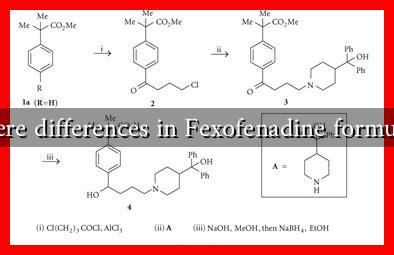-
Table of Contents
Are There Differences in Fexofenadine Formulations?
Fexofenadine is a widely used antihistamine, primarily prescribed for the relief of allergy symptoms such as hay fever and hives. As with many medications, fexofenadine is available in various formulations, each designed to cater to different patient needs and preferences. This article explores the differences in fexofenadine formulations, their effectiveness, and considerations for patients and healthcare providers.
Understanding Fexofenadine
Fexofenadine is a second-generation antihistamine that works by blocking the action of histamine, a substance in the body that causes allergic symptoms. Unlike first-generation antihistamines, fexofenadine is less likely to cause sedation, making it a preferred choice for many individuals. It is available in several formulations, including:
- Tablets
- Orally disintegrating tablets
- Suspensions
- Extended-release formulations
Formulation Variations
Each formulation of fexofenadine has unique characteristics that may influence its effectiveness and suitability for different patients. Here’s a closer look at the various formulations:
1. Tablets
Standard fexofenadine tablets are the most common form. They are typically available in 30 mg, 60 mg, and 180 mg doses. These tablets are swallowed whole and are effective for treating seasonal allergic rhinitis and chronic urticaria.
2. Orally Disintegrating Tablets
Orally disintegrating tablets (ODTs) dissolve quickly in the mouth without the need for water. This formulation is particularly beneficial for patients who have difficulty swallowing pills, such as children or the elderly. Studies have shown that ODTs provide similar efficacy to standard tablets, making them a viable alternative.
3. Suspensions
Fexofenadine suspensions are liquid formulations that are often prescribed for pediatric patients. The liquid form allows for easier dosage adjustments based on the child’s weight and age. Research indicates that suspensions can be just as effective as solid forms, provided the correct dosage is administered.
4. Extended-Release Formulations
Extended-release (ER) formulations are designed to release the medication slowly over time, allowing for once-daily dosing. This can improve patient compliance, as it reduces the frequency of administration. Studies have shown that ER formulations maintain therapeutic levels of fexofenadine for longer periods, making them suitable for patients with persistent symptoms.
Comparative Effectiveness
While all formulations of fexofenadine are effective in treating allergy symptoms, some studies suggest slight variations in their pharmacokinetics and patient preferences:
- Onset of Action: Some patients report that ODTs provide a quicker onset of relief compared to standard tablets.
- Duration of Action: Extended-release formulations may offer longer-lasting relief, which is beneficial for those with chronic conditions.
- Patient Preference: The choice of formulation often depends on individual preferences, such as ease of use and lifestyle considerations.
Case Studies and Statistics
A study published in the Journal of Allergy and Clinical Immunology found that patients using ODTs reported a 20% higher satisfaction rate compared to those using standard tablets. Additionally, a survey conducted by the American Academy of Allergy, Asthma & Immunology indicated that 65% of patients preferred extended-release formulations for their convenience.
Conclusion
In summary, fexofenadine is available in various formulations, each with its own advantages and considerations. While all formulations are effective in managing allergy symptoms, differences in onset of action, duration, and patient preference can influence the choice of formulation. Understanding these differences can help patients and healthcare providers make informed decisions tailored to individual needs. As always, it is essential to consult with a healthcare professional before making any changes to medication regimens.




